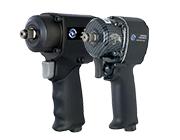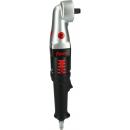Bodywork keys

Bodywork spanners for cars
︾
Bodywork spanners: Discover all our tools for your bodywork tightening work:
Bodywork impact spanners, particularly pneumatic impact spanners and ratchets, play a crucial role in the automotive bodywork industry. These tools are used to quickly tighten and loosen bolts and nuts, making repair and assembly work easier. Let's take a look at the distinctive features of each of these spanners.
1. Pneumatic impact spanner :
The pneumatic impact spanner is powered by compressed air and is a popular choice in body shops. Here are some of its key features:
High power: Pneumatic impact spanners offer high power, making them ideal for loosening tight nuts and bolts, such as those found in bodywork components.
High rotational speed: They have a high rotational speed, enabling them to work quickly and efficiently. This is particularly advantageous when handling multiple fasteners during bodywork.
Lightweight : Compared with some electric alternatives, pneumatic impact spanners are often lighter, which reduces user fatigue during prolonged use.
Simplified maintenance: They generally require less maintenance than other types of impact spanner. Good maintenance mainly involves regular lubrication to ensure optimum operation.
Torque control: Some models offer adjustable torque control, allowing the user to set the tightening force to suit the specific requirements of the job.
2. Ratchet spanner :
The ratchet spanner, also known as a ratchet, is a manual alternative often used in situations where space is limited or precise control is required. Here are some key features of the ratchet spanner:
Manual action : Unlike the pneumatic impact spanner, the ratchet spanner is manually operated. This offers more direct control over the application of torque.
Precision : The ratchet is often preferred for tasks requiring precise application of force, such as assembling delicate bodywork parts.
Versatility : Because it is manually operated, the ratchet can be used in confined spaces where access is difficult for larger tools.
No need for electric or pneumatic power: It does not require electric or pneumatic power, which can be an advantage in environments where these power sources are not readily available.
Variety of sizes : Available in a variety of socket sizes, the ratchet can be adapted to different sizes of nuts and bolts encountered in bodywork.
In summary, both pneumatic impact spanners and ratchets are essential tools in the car body repair trade, each offering specific advantages depending on the particular needs of the task in hand. The choice between the two often depends on the nature of the work, the space available, and the user's preferences.
The differences between the pneumatic impact spanner and the ratchet spanner:
The ratchet spanner and the pneumatic impact spanner are two types of tool used to tighten and loosen nuts and bolts, but they differ significantly in their operation, features and applications. Here are the main differences between these two types of spanner:
1. Mode of operation :
Ratchet spanner: The ratchet spanner is a manual tool operated by the user. It uses a ratchet mechanism to apply torque to a nut or bolt. The user must turn clockwise or anti-clockwise to tighten or loosen.
Pneumatic impact spanner: The pneumatic impact spanner uses compressed air. It uses a mechanical anvil that generates pulses of rotation when supplied with air. These pulses of rotation enable fasteners to be tightened or loosened quickly without the need for continuous movement on the part of the user.
2. Power and speed :
Ratchet spanner: Power depends entirely on the manual strength of the user. It generally offers less torque than an impact spanner, and tightening/untightening speed is limited to the speed with which the user can make turning movements.
Pneumatic impact spanner: Offers greater power thanks to its percussion mechanism. Pneumatic impact spanners can deliver high torque at fast rotation speeds, enabling bolts to be tightened and loosened quickly and efficiently.
3. Applications :
Ratchet spanner : Because of its manual operation, the ratchet spanner is often used in situations where precise control is required. It is suitable for applications requiring a specific clamping force and where high power is not always required.
Pneumatic impact spanner: Because of its power and speed, the pneumatic impact spanner is commonly used in environments where a high clamping force is required, such as in automotive workshops, mechanical engineering and other industrial applications.
4. Size and weight :
Ratchet Wrench: In general, ratchet spanners are lighter and more compact, making them easy to manoeuvre in tight spaces.
Pneumatic impact spanner: Because of their internal mechanism and energy source (compressed air), pneumatic impact spanners can be larger and heavier.
In short, the choice between a ratchet spanner and a pneumatic impact spanner depends on the specific needs of the task in hand. The ratchet spanner is often preferred for applications requiring precise control, while the pneumatic impact spanner excels in jobs requiring high power and speed of execution.
FAQ : How do I use bodywork spanners?
The use of spanners in car bodywork frequently raises questions from users looking to optimise the efficiency of their work while preserving the integrity of components. Let's take a look at some of these questions and provide professional answers to guide users in their use of bodywork spanners.
What is the difference between a pneumatic impact spanner and a torque spanner for tightening bodywork bolts?
The pneumatic impact spanner uses pulses of rotation to quickly tighten bolts, ideal for sturdy bodywork fasteners. A torque spanner, on the other hand, is designed to apply a precise torque and is often used in situations where precise tightening is crucial to prevent damage or to meet specific specifications.
How can I avoid overtightening bolts with a bodywork impact spanner?
To avoid overtightening, use an impact spanner with an adjustable torque. Adjust the torque according to the bodywork manufacturer's specifications or the car manufacturer's recommendations. Using a torque spanner for precise final tightening is also good practice.
What's the best spanner for bodywork in confined spaces?
For tight spaces, a ratchet spanner is often the best choice. Its compact design allows easy access to hard-to-reach places. Choose a quality ratchet spanner with a pivoting head for maximum manoeuvrability.
How do I choose the right size socket for a bodywork spanner?
Choose the right size socket for the fastener you need to tighten or loosen. Make sure it fits the head of the screw or nut correctly to avoid slipping and damage.
How do I maintain a pneumatic impact spanner to ensure it lasts?
Regular maintenance is essential. Lubricate the tool in accordance with the manufacturer's recommendations. Also check the air pressure regularly to ensure optimum performance and prevent any risk of overloading.
Which spanner should I use to remove plastic bodywork parts without damaging them?
For dismantling delicate plastic parts, a manual ratchet is often recommended. It allows controlled tightening and reduces the risk of damage to fragile components.
To sum up, the judicious use of bodywork spanners requires a thorough understanding of the specific features of each tool and the particular needs of the task in hand. By following good practice and using the right tools, bodywork professionals can ensure accurate results while preserving the integrity of components.
